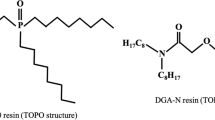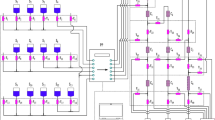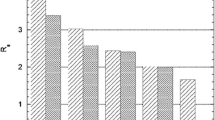Abstract
Sequential separation methods are key for rapid determination of multiple radionuclides. Seven different activation and fission products were isolated by two different sized anion exchange columns after a UTEVA/ TRU double stack. First, a 6 mL column of AG1-x8 separated Cd, Zn, Co, and Ir. The Cd recoveries were quantitative, with a decontamination factor of 106 from 132Te, a fission product interferent. Next, a 2 mL AG1-x8 column further separated the Fe/Ga/Te fraction from the first column. Ascorbic acid was used to control redox conditions, allowing for separation of Fe, Ga, and Te. With the use of two anion exchange columns, seven elements can be rapidly separated from a mixed activation/ fission product sample.



Similar content being viewed by others
References
Gonzales E, Garcia S, Mahan C, Hang W (2005) Evaluation of mass spectrometry and radiation detection for the analysis of radionuclides. J Radioanal Nucl Chem 263:457–465
Morley SM, Seiner B, Finn E, Greenwood L, Smith SC, Gregory S, Haney M, Lucas D, Arrigo L, Beacham T (2015) Integrated separation scheme for measuring a suite of fission and activation products from a fresh mixed fission and activation product sample. J Radioanal Nucl Chem 304:509–515
Jiang J, Davies A, Arrigo L, Friese J, Seiner BN, Greenwood L, Finch Z (2021) Analysis of 161Tb by radiochemical separation and liquid scintillation counting. Appl Radiat Isot 170:107298
Doyle J (2011) Nuclear safeguards, security and nonproliferation: achieving security with technology and policy. Elsevier
Nichols A, Verpelli M, and Aldama D (2008) Handbook of nuclear data for safeguards: database extensions, August 2008. IAEA
Seiner BN, King AR, Finn E, Greenwood LR, Metz LA, Friese J, Marsden O, Davies AV, Scivier P (2016) Fission product analysis of HEU irradiated within a boron carbide capsule: comparison of detection methodology at PNNL and AWE. J Radioanal Nucl Chem 307:1729–1734
Dry DE, Bauer E, Petersen LA (2005) Rapid separation of fresh fission products. J Radioanal Nucl Chem 263:19–22
Roach BD, Fenske EK, Glasgow DC, Partridge JD, Keever TJ, Giaquinto JM (2019) Rapid concentration and isotopic measurements of ultra-trace 235U fission products with comparison to an ORIGEN isotope depletion model. Talanta 205:120079
McAlister DR and Horwitz EP (2011) Chromatographic generator systems for the actinides and natural decay series elements.
Michel H, Gasparro J, Barci-Funel G, Dalmasso J, Ardisson G, Sharovarov G (1999) Radioanalytical determination of actinides and fission products in Belarus soils. Talanta 48:821–825
Douglas M, Friese J, Greenwood L, Farmer O, Thomas M, Maiti T, Finn E, Garofoli S, Gassman P, Huff M (2009) Separation and quantification of chemically diverse analytes in neutron irradiated fissile materials. J Radioanal Nucl Chem 282:63–68
Arrigo L, Herman S, and Arnold E (2020) Flowsheet Improvements FY19 Results. Pacific Northwest National Laboratory.
Korkisch J (1988) CRC handbook of ion exchange resins. CRC Press
Faris JP (1978) Separation of metal ions by anion exchange in mixtures of hydrochloric acid and hydrofluoric acid. Argonne National Lab., IL (USA). p. Medium: ED; Size: Pages: 67.
Walton HF (1965) Ion exchange in analytical chemistry. ACS Publications.
Nelson F, Rush RM, Kraus KA (1960) Anion-exchange studies. XXVII. Adsorbability of a number of elements in HCl-HF solutions1, 2. J Am Chem Soc 82:339–348
Faris JP and Buchanan RF (1964) Anion exchange characteristics of the elements in nitric acid and nitrate solutions and application in trace element analysis. Argonne National Lab., Ill. p. Medium: ED; Size: Pages: 29.
Kraus KA, Nelson F, Smith GW (1954) Anion exchange studies. IX. Adsorbability of a number of metals in hydrochloric acid solutions. J Phys Chem 58:11–17
Rao GG, Rao VN (1955) Ascorbic acid as a reducing agent in quantitative analysis. Fresenius’ Zeitschrift Anal Chem 147:338–347
Borsook H, Keighley G (1933) Oxidation-reduction potential of ascorbic acid (Vitamin C). Proc Natl Acad Sci USA 19:875–878
Haynes WM, Lide DR, Bruno TJ (2016) CRC handbook of chemistry and physics. CRC Press
Bouroushian M (2010) Electrochemistry of the Chalcogens. Springer, Berlin
Acknowledgements
This work was sponsored by the Office of the Deputy Assistant Secretary of Defense for Nuclear Matters. We would like to thank the Radiological Processing Laboratory (RPL) service center at PNNL for gamma emission analysis data. PNNL is operated by Battelle for the U.S. Department of Energy (DOE) under Contract No. DE-AC05-76RL0-1830. PNNL draws on signature capabilities in chemistry, earth sciences, and data analytics to advance scientific discovery and create solutions to the nation's toughest challenges in energy resiliency and national security.
Author information
Authors and Affiliations
Corresponding author
Ethics declarations
Conflict of interest
The authors declare that there is no conflict of interest.
Additional information
Publisher's Note
Springer Nature remains neutral with regard to jurisdictional claims in published maps and institutional affiliations.
Rights and permissions
Springer Nature or its licensor (e.g. a society or other partner) holds exclusive rights to this article under a publishing agreement with the author(s) or other rightsholder(s); author self-archiving of the accepted manuscript version of this article is solely governed by the terms of such publishing agreement and applicable law.
About this article
Cite this article
Herman, S., Arrigo, L.M., Arnold, E. et al. Evaluation of AG1-x8 to separate radionuclides in an irradiated sample. J Radioanal Nucl Chem 331, 5107–5112 (2022). https://doi.org/10.1007/s10967-022-08601-w
Received:
Accepted:
Published:
Issue Date:
DOI: https://doi.org/10.1007/s10967-022-08601-w




